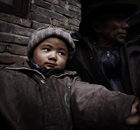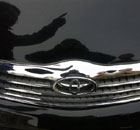Focus
Civilians to the rescue
By Wang Wen (China Daily)
Updated: 2010-03-09 09:26
 |
Large Medium Small |
But maybe not for much longer as teams struggle for funding
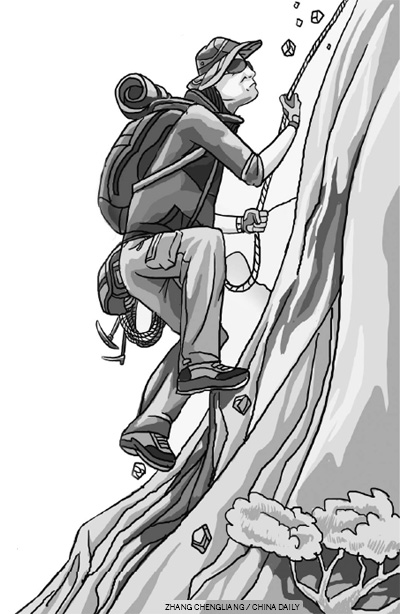
Twenty-one members of the Peking University Mountaineering Association (PUMA) were stranded while hiking on Xiaowutai Mountain, 180 km from downtown Beijing, on Feb 28. They were finally rescued on March 1 by 15 members of the Lantian rescue team and another five members of PUMA.
But stranded hikers may not be as lucky in the future, with civilian-run rescue teams, such as Lantian, struggling to find enough funding to survive.
It wasn't until about seven or eight years ago that Beijingers started to take up outdoor activities, such as hiking and rock climbing, in large numbers.
The Luye rescue team, which is now probably the most highly acclaimed rescue team in Beijing, said that, based on its own surveys, the number of people participating in outdoor activities in Beijing was about 1,500,000 in 2008. The team estimates that number has increased to more than 3 million now.
However, almost all these hikers, climbers and other outdoor enthusiasts are self-organized and have little knowledge of safety and how to properly use equipment.
As the number of hikers in Beijing increased in recent years, many accidents happened and the need for rescue teams became obvious. Both the Luye rescue team and the Shanyue rescues teams were established in 2003.
The Shanyue team was set up under the administration of the Beijing Mountaineering Association and eventually became part of the Ministry of Civil Affairs of China in 2008.
The citizen-run Luye team had its business suspended after six months due to a lack of funding.
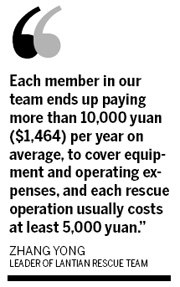
It was not until 2007, when a female editor with China Central Television died while climbing Lingshan Mountain in Beijing's Mentougou district, that Luye was revived. The accident caused disputes between her family and the guides who organized the activity and created a great deal of debate among hikers in Beijing. The Luye team has since made several high-profile rescues, to which it probably owes its top-level reputation.
Several other citizen-run rescue teams were set up in Beijing and across China after the accident that sparked Luye's re-establishment.
So far, there are 86 rescue teams in China and about 10 large rescue teams in Beijing, said Lu Zhonghong, the leader of the Luye team.
Last year, the Luye team successfully undertook nine rescue operations and the Lantian team undertook 23. The Lantian team used to be part of the Luye team but separated from it in late 2008 after an argument between members.
Over the past two years, Lantian has developed into the biggest rescue team in Beijing in terms of numbers, with more than 280 members. However, funding is still a big problem for the Lantian team.
"Each member in our team ends up paying more than 10,000 yuan ($1,464) per year on average, to cover equipment and operating expenses, and each rescue operation usually costs at least 5,000 yuan," said Zhang Yong, leader of the Lantian team.
Membership fees support most rescue teams in Beijing, but these are often barely enough - and sometimes not enough - to cover costs. Citizen-run rescue teams are not registered as nongovernmental organizations with the Ministry of Civil Affairs and so can't legally accept donations.
| ||||
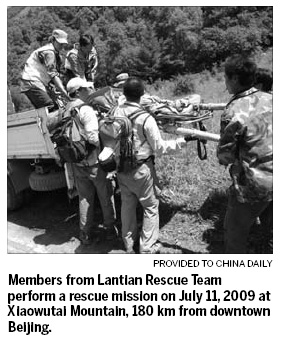
The Lantian rescue team opted to collaborate with the government and will be registered with the Ministry of Civil Affairs later this month.
The team will then be able to collect donations and get subsidies from the government.
But the answer to the Lantian's funding problem means potentially losing some control over the team's operation, according to Zhang.
The Lantian team will only be regarded as an assistant to the government's rescue system, no matter how successful the team is, he said.
"Luye will think more about which option to choose - collaboration with nongovernmental organizations or with the government - when we see how much the government invests, in terms of human resources and funds, on the rescue teams who choose to operate under it, " said Lu.
Lu said the government has better equipment than his rescue team and that the staff of the government rescues systems were trained professionals, but that civil rescue teams, such as his, have a considerable advantage in being familiar with the routes on the mountains.


